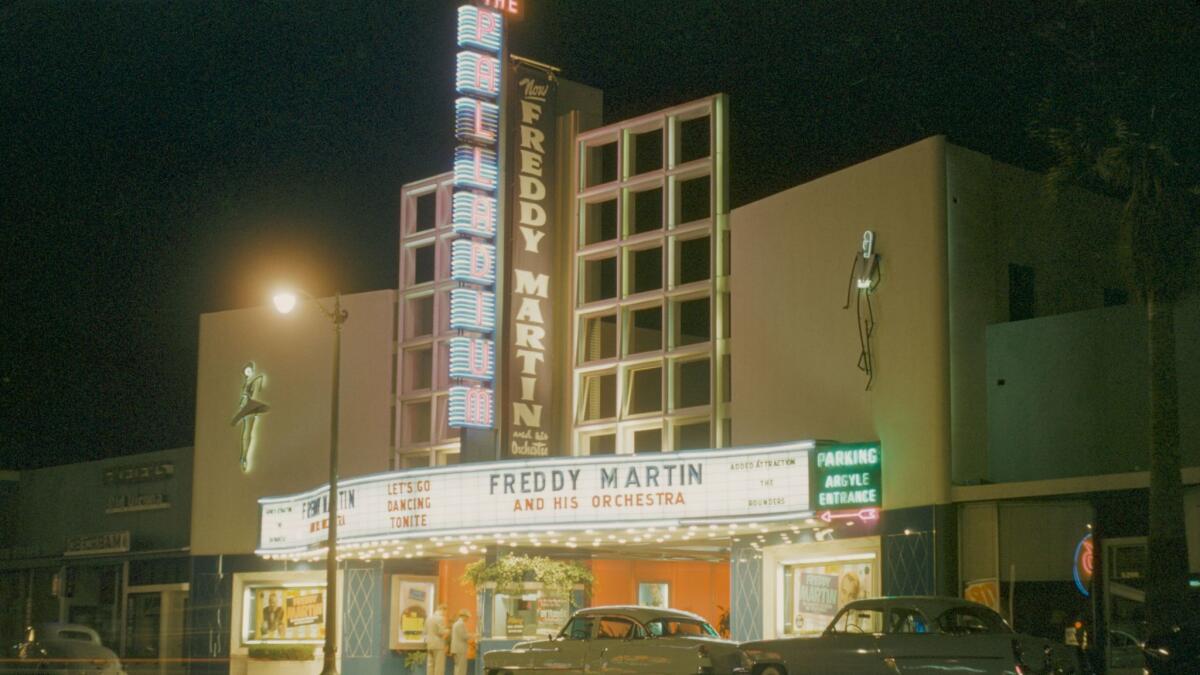As jazz waned, the Hollywood Palladium helped popularize the Latin music craze

- Share via
If Sunset Boulevard represents a kind of metaphorical artery pumping rhythms across the city and around the world, worth examining is how those sounds were built, heard and danced to.
“We always need a through line, and I’m intrigued by the street itself as the through -line that cuts east to west,” says Anthony Macias, assistant professor of ethnic studies at the University of California, Riverside.
There’s a strong argument to be made that the Hollywood Palladium marks the center of that line.
Macias, who wrote “Mexican American Mojo: Popular Music, Dance, and Urban Culture in Los Angeles, 1935-1968,” says that his reflex when considering Sunset is to think of “the early punk scene and the hair bands at the Whisky a Go Go.”
But that only tells part of the story.
FULL COVERAGE: Mapping Sunset Boulevard’s musical history »
Missing, for example, is how venues such as the Palladium and Club Havana in Silver Lake, which in the 1950s and ‘60s hosted Latin big bands including Tito Puente and Pérez Prado, served as points of cultural convergence.
Club Havana “had a battle of the bands,” Macias says. “It had enough room for two stages, so it must have been a pretty big venue. And those Latin bands were big — they weren’t the little quintets at that point.”
Macias cites another little Sunset venue a few blocks west called Ramona’s, where Cuban conga player Mongo Santamaria had a band in the early 1960s.
A few miles farther west, the Palladium in the ‘50s was struggling to fill its massive dance floor while adapting to the decline of the big band era.
Mexican Americans, who had formerly been hassled at the Palladium for their dress, were hitting Sunset. If they dressed conservatively there wasn’t a problem, says Macias, “but sometimes if they looked like pachucos they would try and stop them at the box office or at the door.”
In such cases, adds Macias, attendees forced bouncers to confront the hypocrisy: “‘You can measure my cuffs. I’m not wearing a zoot suit.’ They forced their own way.”
Macias says the Palladium started booking Latin bands, which were composed mostly of Mexican American and other Latino musicians, in the early ’50s to perform during intermissions, “but jazz waned in popularity and this Latin craze hit. By the mid-’50s the mambo and the cha-cha-cha were all the rage.”
In 1955, the disc jockey Lionel “Chico” Sesma started promoting his Latin Holidays at the Palladium, in the process transforming the venue. The DJ, who is credited with popularizing the mambo and cha-cha in Los Angeles, commenced an annual event that endured for decades.
Still, just because mambo fans cruised to the Palladium didn’t mean they rolled to Ben Frank’s for burgers on the Strip later. Writes Macias in “Mexican American Mojo”: “Although people may have mixed in particular dance venues, this contact did not necessarily continue outside of the music scene, or back in their respective neighborhoods.”
The result was a gradual assimilation as Sunset culture evolved and as Latinos “went from being sort of ‘non-black’ and therefore admitted as patrons, to actually being permitted onstage, to being booked and being requested as Latin music got popular,” Macias says.
Unlike Club Havana (or its predecessor in the spot, El Serape), the Palladium still stands. Although it’s been dormant from time to time since its rise, the venue, which is now owned by Live Nation, isn’t going anywhere.
Asked about another enduring Latin spot, Club Bahia — the first music venue, geographically speaking, on Sunset — and Macias laughs with recognition.
“I courted my wife — I took her dancing there,” he says, adding with surprise: “Oh yeah, that’s on Sunset too. If you only think of the Strip, you forget about all these other joints.”
For tips, records, snapshots and stories on Los Angeles music culture, follow Randall Roberts on Twitter and Instagram: @liledit. Email: randall.roberts@latimes.com.
More to Read
The biggest entertainment stories
Get our big stories about Hollywood, film, television, music, arts, culture and more right in your inbox as soon as they publish.
You may occasionally receive promotional content from the Los Angeles Times.











